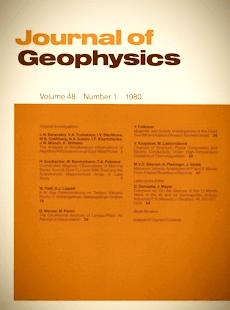A late Cretaceous 40Ar-39Ar age for the Lappajarvi impact crater, Finland
Article Sidebar
Published:
Mar 27, 1980
Keywords:
Impact cratering,
40Ar — 39Ar,
Meteorites,
Karnaite,
Rb—Sr dating,
Impact melt,
Rate of impacts,
Chronology,
Melt sheet
Volumes

Vols. 1-18 (1924-1944), ISSN 0044-2801
Main Article Content
E.K. Jessberger
Max Planck Institute for Nuclear Physics, Heidelberg Germany
W.U. Reimold
Institute for Mineralogy, Munster Germany
Abstract
We report on a 40Ar — 39Ar study of karnaite from the ⁓ 17 km Lappajarvi impact crater, Finland. Four samples from a 3,000 m profile across the crater center give rather well defined age plateaux and indicate complete degassing at the time of the impact event. The mean age is 77 m.y., much younger than geologically derived age estimates.
 ARK: https://n2t.net/ark:/88439/y062490
ARK: https://n2t.net/ark:/88439/y062490
Permalink: https://geophysicsjournal.com/article/186
Article Details
How to Cite
Section
References
Bottomley, R.J., York, D., Grieve, R.A.F. (1978) 40Ar- 39Ar dating of Scandinavian impact craters. Contrib. Mineral. Petrol. 68:79-84
Elo, S. (1976) A study of the gravity anomaly associated with Lake Lappajarvi, Finland. Geol. Surv. Finland
Fredriksson, K., Wickman, F.E. (1963) Meteoriter, Sven. Naturvetensk. 16:121-157
Gobel, E., Reimold, W.U., Baddenhausen, H., Palme, H. (1980) The projectile of the Lappajarvi impact crater, Naturwissenschaften (In press)
Grieve, R.A.F., Robertson, P.B. (1979) The terrestrial cratering record I. Current status of observation. Icarus 38:212-229
Jager, E., Niggli, E., Baethge, H. (1963) Two standard minerals, biotite and muscovite for Rb- Sr and K -Ar age determinations, samples Bern 4B and Bern 4M from a gneiss from Brione, Valle Verzasca (Switzerland). Schweiz. Mineral. Petrogr. Mitt. 43:465-470
Jessberger, E.K., Huneke, J.C., Wasserburg, G.J. (1974) Evidence for a 4.5 AE age of plagioclase clasts in a lunar highland breccia. Nature 248:199-202
Jessberger, E.K., Kirsten, T., Staudacher, Th. (1976) Argon-argon ages of consortium breccia 73215. Proc. 7th Lunar Sci. Conf. 2201-2215
Lehtinen, M. (1976) Lake Lappajarvi, a meteorite impact site in western Finland. Geol. Surv. Finl. Bull. 282, Dissertation
Maerz, U. (1979) Petrographisch-chemische Untersuchungen von Impaktschmelzen und Brekzien skandinavischer Meteoritenkrater. Diploma Thesis, Institut fur Mineralogie, Universitat Munster
Maerz, U., Reimold, W.U., Stoffler, D. (1979) Preliminary results on the petrography and Rb-Sr isotope geochemistry of the Lappajarvi impact melt. Lunar Planet. Sci., 769-771, The Lunar Planet. Inst., Houston
Neukum, G., Wise, D.U. (1976) Mars — a standard crater curve and possible new time scale. Science 194:1381-1384
Reimold, W.U. (1979) Rb — Sr- und Multielement-Analysen von Gesteinen des Lappajarvi-Meteoritenkraters. Fortschr. Mineral. 57 (Beiheft 1):123-124
Reimold, W.U., Stoffler, D. (1979) Isotope, major and trace element chemistry of the Lappajarvi impact melt. Meteoritics (In press)
Steiger, R.H., Jager, E. (1977) Subcommission on Geochronology: Convention on the use of decay constants in geo- and cosmochronology. Earth Planet. Sci. Lett. 36:359-362
Svensson, N.B. (1968) Lake Lappajarvi, Central Finland: A possible meteorite impact structure. Nature 217:438
Elo, S. (1976) A study of the gravity anomaly associated with Lake Lappajarvi, Finland. Geol. Surv. Finland
Fredriksson, K., Wickman, F.E. (1963) Meteoriter, Sven. Naturvetensk. 16:121-157
Gobel, E., Reimold, W.U., Baddenhausen, H., Palme, H. (1980) The projectile of the Lappajarvi impact crater, Naturwissenschaften (In press)
Grieve, R.A.F., Robertson, P.B. (1979) The terrestrial cratering record I. Current status of observation. Icarus 38:212-229
Jager, E., Niggli, E., Baethge, H. (1963) Two standard minerals, biotite and muscovite for Rb- Sr and K -Ar age determinations, samples Bern 4B and Bern 4M from a gneiss from Brione, Valle Verzasca (Switzerland). Schweiz. Mineral. Petrogr. Mitt. 43:465-470
Jessberger, E.K., Huneke, J.C., Wasserburg, G.J. (1974) Evidence for a 4.5 AE age of plagioclase clasts in a lunar highland breccia. Nature 248:199-202
Jessberger, E.K., Kirsten, T., Staudacher, Th. (1976) Argon-argon ages of consortium breccia 73215. Proc. 7th Lunar Sci. Conf. 2201-2215
Lehtinen, M. (1976) Lake Lappajarvi, a meteorite impact site in western Finland. Geol. Surv. Finl. Bull. 282, Dissertation
Maerz, U. (1979) Petrographisch-chemische Untersuchungen von Impaktschmelzen und Brekzien skandinavischer Meteoritenkrater. Diploma Thesis, Institut fur Mineralogie, Universitat Munster
Maerz, U., Reimold, W.U., Stoffler, D. (1979) Preliminary results on the petrography and Rb-Sr isotope geochemistry of the Lappajarvi impact melt. Lunar Planet. Sci., 769-771, The Lunar Planet. Inst., Houston
Neukum, G., Wise, D.U. (1976) Mars — a standard crater curve and possible new time scale. Science 194:1381-1384
Reimold, W.U. (1979) Rb — Sr- und Multielement-Analysen von Gesteinen des Lappajarvi-Meteoritenkraters. Fortschr. Mineral. 57 (Beiheft 1):123-124
Reimold, W.U., Stoffler, D. (1979) Isotope, major and trace element chemistry of the Lappajarvi impact melt. Meteoritics (In press)
Steiger, R.H., Jager, E. (1977) Subcommission on Geochronology: Convention on the use of decay constants in geo- and cosmochronology. Earth Planet. Sci. Lett. 36:359-362
Svensson, N.B. (1968) Lake Lappajarvi, Central Finland: A possible meteorite impact structure. Nature 217:438











